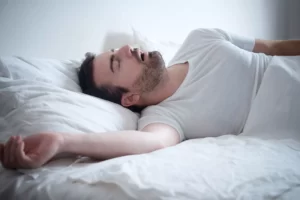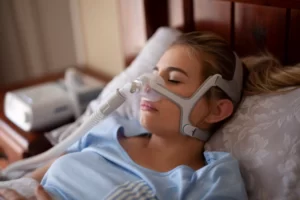Snoring Treatment In Singapore
Forty-five percent of normal adults snore at least occasionally and twenty-five percent are habitual snorers. Problem snoring is more frequent in males and overweight people and usually worsens with age. Snoring may be an indication of obstructed breathing and should not be taken lightly. We can help you to determine where the anatomic source of your snoring may be, and offer solutions for this noisy and often embarrassing behavior.
What Is Snoring?
 Snoring is a sound which occurs when there is an obstruction to the free flow of air through the passages at the back of the mouth and nose. This area is the collapsible part of the airway where the tongue and upper throat meet the soft palate and uvula. Snoring occurs when these structures strike each other and vibrate during breathing.
Snoring is a sound which occurs when there is an obstruction to the free flow of air through the passages at the back of the mouth and nose. This area is the collapsible part of the airway where the tongue and upper throat meet the soft palate and uvula. Snoring occurs when these structures strike each other and vibrate during breathing.
In children, snoring may be a sign of problems with the tonsils and adenoids. A chronically snoring child should be examined by an ENT specialist, who may recommend a tonsillectomy and adenoidectomy to return the child to full health.
How Does Snoring Affect Me?
Medically
Snoring disturbs sleeping patterns and deprives the snorer of adequate rest. It may be a sign of Obstructive Sleep Apnea (OSA), which can lead to serious, long-term health problems.
Socially
Snoring can also make the snorer an object of ridicule and can cause the bed partner to experience many sleepless nights and fatigue. It is not uncommon for the bed partner to sleep in a separate room if the patient’s snoring is intolerable.
How Is Snoring Evaluated By An ENT Specialist?
Heavy snorers should seek medical advice to ensure that they do not have underlying OSA. Heavy snorers include people who snore constantly in any position or who negatively impact a bed partner’s sleep.
The nose, mouth, throat, palate, and neck are examined carefully often using a fiberoptic scope in a procedure called nasoendoscopy. This examination can reveal if the snoring is caused by nasal allergy, infection, nasal obstruction, or enlargement of tonsils and adenoids. A sleep study in hospital or at home may be necessary to determine if snoring is due to OSA.
All snorers with any of the following symptoms should be evaluated for possible obstructive sleep apnea:
- Witnessed episodes of breath pauses during sleep
- Daytime sleepiness or fatigue
- High blood pressure
- Heart disease
- History of a stroke
What Is Obstructive Sleep Apnea (OSA)?
 Snoring may be a indication of a more serious condition known as obstructive sleep apnea (OSA). OSA is characterized by multiple episodes of breathing pauses greater than 10 seconds at a time, due to collapse or severe narrowing of the upper airway. This results in lower amounts of oxygen in the blood, which causes the heart to work harder. It also causes disruption of the natural sleep cycle, which makes people feel poorly rested despite adequate time in bed. Patients with OSA may experience 30 to 300 such events per night.
Snoring may be a indication of a more serious condition known as obstructive sleep apnea (OSA). OSA is characterized by multiple episodes of breathing pauses greater than 10 seconds at a time, due to collapse or severe narrowing of the upper airway. This results in lower amounts of oxygen in the blood, which causes the heart to work harder. It also causes disruption of the natural sleep cycle, which makes people feel poorly rested despite adequate time in bed. Patients with OSA may experience 30 to 300 such events per night.
The immediate effect of OSA is that the snorer must sleep lightly and keep the throat muscles tense to prevent narrowing of the upper airway. As the snorer does not get good quality sleep, he or she may be sleepy during the day, which may impair job performance and makes him or her a hazardous driver or equipment operator.
Untreated obstructive sleep apnea increases the risk of developing heart attacks, strokes, diabetes, respiratory issues and many other medical conditions.
OSA can be classified by severity into mild, moderate and severe, depending on the results of the sleep study. Taking into account the patient’s physical findings, appropriate treatment can be recommended.
What Available Snoring Treatment in Singapore Are There?
The treatment prescribed depends on the diagnosis and level(s) of upper airway narrowing causing obstruction. Frequently, more than one level of obstruction is identified. In general, treatment can be divided into non-surgical vs. surgical methods.
Non-Surgical Methods for Treatment of Obstructive Sleep Apnea (OSA)
Lifestyle Modification Strategies
Lifestyle modification, especially weight loss, sleep hygiene and exercise, are often recommended. These can help by relieving pressure and increasing muscle tone in the airway.
Oral Appliances
A custom-fit oral appliance, which repositions the lower jaw forward, may also be considered for certain patients with snoring/OSA. This should be fitted by an otolaryngologist, dentist, or oral surgeon with expertise in sleep dentistry.
Devices
 Obstructive sleep apnea is most often treated with a device that opens the airway with a small amount of positive pressure. This pressure is delivered via a nasal or face mask worn during sleep. This treatment is called continuous positive airway pressure (CPAP). It is currently the initial treatment of choice for patients with OSA.
Obstructive sleep apnea is most often treated with a device that opens the airway with a small amount of positive pressure. This pressure is delivered via a nasal or face mask worn during sleep. This treatment is called continuous positive airway pressure (CPAP). It is currently the initial treatment of choice for patients with OSA.
Patients who fail CPAP or are unable to tolerate the treatment may be candidates for surgery.
Surgical Methods For Treatment Of Obstructive Sleep Apnea (OSA)
Tonsillectomy & Adenoidectomy
Tonsils are small, round pieces of tissue located in the back of the mouth on both sides of the throat. Adenoids are similar to tonsils but located in back of the nasal cavity.
Enlarged tonsils and adenoids will contribute to airway narrowing, which precipitate and worsen OSA. The procedure to remove tonsils is known as a tonsillectomy, and removal of the adenoids is called an adenoidectomy. Because they are often removed at the same time, the procedure is referred to as a tonsillectomy and adenoidectomy.
Uvulopalatopharyngoplasty (UPPP/UP3)
Uvulopalatopharyngoplasty (UPPP) is a surgery for treating snoring and obstructive sleep apnea. It removes excess soft palate tissue, tightens the pharynx and opens the airway. In addition, the remaining tissue stiffens as it heals, thereby minimizing tissue vibration.
Inferior Turbinate Reduction
Inferior turbinate reduction is a procedure that reduces the size of the inferior turbinates in the nose. There are a variety of procedures in-clinic (under local anaesthesia) or surgeries (under general anesthesia) that can reduce, remove or displace the obstructive turbinate tissue, through different cutting-edge technologies involving radiofrequency energy or conventional tissue removal.
Inferior turbinate reduction works by shrinking the inferior turbinates, thus removing the obstruction preventing a clear flow of air through the nasal passages. Thus, the surgery reduces the size of this obstruction, while preserving the very important functions of the inferior turbinates. Improving nasal patency can reduce mouth breathing and the severity of snoring and OSA.
Septoplasty
Septoplasty is a surgery performed to correct a deviated nasal septum. The nasal septum is a partition in your nose made from cartilage and bone. It separates the internal nasal cavity into the right and left sides. A deviated nasal septum is used to describe a condition where this partition is crooked, subsequently narrowing one side of the nasal cavity. Improving nasal patency can reduce mouth breathing and the severity of snoring and OSA.
Tongue Base Reduction
While there are many tissues in the throat that can contribute to OSA, the tongue is a major factor. The base of the tongue sits directly next to the windpipe, making it very easy for the tongue to relax and fall into the airway, preventing air from entering. In certain patients, the base of the tongue is overly large, causing them to be more prone to OSA. For such patients, tongue base reduction is a minimally invasive surgical procedure to effectively reduce the size of the tongue, relieving the symptoms of sleep apnea. Several treatments may be required.
Soft Palate Stiffening
The soft palate is comprised of five muscles that play different roles in swallowing and breathing. When patients suffer from sleep apnea, it is often due to a relaxation of one of these muscles. There are several procedures that address the soft palate specifically, preventing it from blocking the airway as you sleep.
Palate radiofrequency is a minimally invasive method to reduce excessive tissue that may be responsible for snoring and OSA. During the procedure, local anesthetic is first delivered to the soft palate. A radiofrequency electrode is then placed into the mouth and inserted under the soft palate. Carefully controlled radiofrequency energy is then delivered through the electrode. The energy creates a controlled lesion underneath the soft palate. Over the several weeks following the procedure, the body will resorb the lesion, which reduces and tightens the soft palate. With its newly reduced size and tighter structure, the soft palate will no longer be the cause of unwanted snoring.
Genioglossus and hyoid advancement is a surgical procedure for the treatment of sleep apnea. It prevents collapse of the lower throat and pulls the tongue muscles forward, thereby opening the obstructed airway.
Frequently asked questions
Sleep conditions We treat
- Snoring
- Obstructive Sleep Apnea
- Mouth Breathing
Our Treatments for snoring and sleep apnea
- Continuous Positive Airway Pressure (CPAP) Devices
- Custom-fit Oral Appliances
- Adenoidectomy & Tonsillectomy
- Uvulopalatoplasty (UPPP)
- Inferior turbinate Reduction
- Septoplasty
- Tongue Base Reduction
- Soft Palate Stiffening








